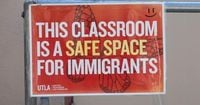On Monday, September 15, 2025, the Supreme Court delivered a decision that has sent shockwaves through immigrant communities, educators, and legal experts across the United States. By lifting a restraining order against so-called "roving patrols" in Los Angeles, the Court cleared the way for federal agents to conduct sweeping immigration operations, a move widely seen as a victory for President Donald Trump's administration. According to reporting from the I-Team and Balls & Strikes, this ruling not only affects Los Angeles but has sparked fears that similar tactics may soon be deployed in cities like Chicago, under the Department of Homeland Security’s newly labeled operation "Midway Blitz."
The immediate effect of the Supreme Court’s action was to stay a lower court order by Judge Maame Ewusi-Mensah Frimpong, who had previously barred federal agents from stopping people based solely on race, language, place of gathering, or type of work. The judge’s ruling was an attempt to curb what she described as "indiscriminate arrests" that cast suspicion on entire communities—especially Latino workers, day laborers, and Spanish-speakers, regardless of citizenship status. However, with the high court’s conservative supermajority intervening, those safeguards have been swept aside, at least for now, in Los Angeles County, home to more than 10 million people, nearly half of whom are Latino.
It remains unclear whether the Supreme Court’s decision will apply beyond Los Angeles, but legal experts and advocates are sounding the alarm. As the I-Team noted, many worry that the same controversial tactics—once restricted by local courts—could soon be used in other major cities, particularly Chicago. The Department of Homeland Security’s codename for its anticipated operation in Chicago, "Midway Blitz," only adds to the sense of urgency and unease among immigrant families and their supporters.
The implications of the Court’s decision extend well beyond city streets and workplaces. According to Balls & Strikes, the Trump administration in January 2025 quietly scrapped a Biden-era policy that had designated "sensitive locations"—such as schools, churches, and hospitals—as off-limits for Immigration and Customs Enforcement (ICE) operations. In its place, a secret directive now gives ICE agents sweeping discretion to act in precisely those formerly protected spaces. The Court’s ruling this week, by effectively blessing constitutionally dubious stops and searches, has compounded the effects of this policy shift. As a result, what was once a guarantee that families could approach schools without fear of arrest has evaporated, replaced by a climate of surveillance and anxiety.
The real-world consequences are already playing out. In Washington, D.C., for example, immigration raids near schools have forced families to upend their daily routines. The once-ordinary rituals of school drop-off and pick-up are now fraught with the possibility of arrest and deportation. Parents have banded together to form "walking school buses"—groups that escort children safely to class—and have taken on new roles, such as giving daycare employees rides to work so they don’t risk being detained during their commutes. The toll on the community has been profound, with student absences piling up as children stay home out of fear.
One parent, speaking to the Washington Post, captured the mood: "We’ve always welcomed law enforcement to come into our buildings to talk to our students. But right now, instead of making us feel safe, they’re making us feel scared and intimidated." The fear is not just psychological—it is backed by policy and a dramatic increase in resources. ICE’s budget has ballooned by nearly $20 billion since last year, with an additional $76 billion on the horizon over the next four years. These funding levels, as Balls & Strikes points out, put ICE’s resources on par with some of the world’s largest militaries. Deportations have surged as well, averaging 1,500 a day as of early August 2025—nearly double the rate seen during the first six months of Trump’s second term.
For local school districts, the situation presents a painful dilemma: Should they submit to becoming extensions of federal immigration enforcement, or stand firm in their role as sanctuaries for learning, trust, and community? The stakes are particularly high for immigrant families, who already live in fear, and for the public education system, which relies on being open and inclusive to serve every child.
In this fraught environment, legal protections like the Family Educational Rights and Privacy Act (FERPA) have become more crucial than ever. FERPA is a federal law that grants parents access to their children’s educational records and, just as importantly, prevents schools from disclosing personally identifiable information (PII) without parental consent. While FERPA does allow exceptions—such as compliance with a lawfully issued subpoena—its core principle is clear: Student records exist to serve families, not to expose them to risk.
Advocates and legal experts urge school districts to take practical steps to honor FERPA’s protections. First, schools should minimize the amount of personal information they collect. Many enrollment forms still ask for Social Security numbers, immigration documents, or parental employment details—none of which are required for public school attendance. Districts are encouraged to strip these questions from their forms and make it clear that such information is unnecessary.
Second, schools should redesign pickup and emergency contact procedures to collect only essential information: the contact’s name, relationship to the student, a phone number, and whether they have custody or pickup permission. This process should be standardized, available in multiple languages, and updated regularly to ensure that every family feels equally part of the school community.
Third, families must be informed about their rights regarding "directory information"—a category under FERPA that includes details like a student’s grade level or participation in extracurricular activities. While schools can share directory information without parental consent, they must notify families in advance and provide an opportunity to opt out. Crucially, emergency contact information should be treated as PII, not directory information, to avoid putting undocumented parents or relatives at risk.
Districts are also advised to regulate disclosures made in response to subpoenas or court orders carefully. ICE agents should be required to present any such orders at the district’s central office, not at the front desk of a school, and legal counsel should review all requests before any information is released. Staff at all levels must be trained to understand what details are protected, when to refuse a request, and how to respond if enforcement agencies appear at the door. Families should be notified of any pending release of information so they can seek protective action if needed.
While school leaders cannot control Supreme Court decisions or federal executive orders, they do have the power to determine how their districts respond when federal immigration enforcement agencies come knocking. Protecting privacy, strengthening legal safeguards, and training staff are not just bureaucratic responsibilities—they are essential to keeping students and families safe in an era of heightened immigration enforcement. For many, the hope is that these measures will help preserve schools as places of refuge, learning, and trust, even as the political and legal landscape shifts around them.

